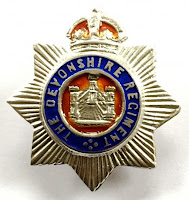Ernest Jackson, born in 1879, was two years younger than John Henry.
He worked at Friths Mill in Todmorden. At different times he is described as a Cotton Mill Hand, a Cotton Mill Labourer, a Cotton Warehouseman, and a Cotton Weaver. At one time there were well over 50 mills in Todmorden and Walsden. Most of the big industrial chimneys have now gone and the mills have been demolished, or stand abandoned, or have been converted for other purposes.
In October Ernest Jackson had 8 days leave away from Exeter and then sailed for France on 15th December 1915. He spent 2 months in hospital suffering from strain but was discharged in February 1916 and sent back to the Firing Line. At this time the Battalion were situated in a village near Albert in the Somme region.
Ernest Jackson had been back with his battalion for only about 4 months when he was killed in action on 1st July 1916. This day was the 1st day of the Battle of the Somme. There were over 57000 British casualties with over 19000 soldiers killed.
Despite the losses the attack was successful and Mametz was captured.
The 8th and 9th Devonshires had the task of attacking German trenches below the fortified village of Mametz. They left their assembly trench and reached an area between Mansel Copse and the main road but the Germans had placed a machine gun in the cemetery in Mametz, a place called ‘The Shrine’. The Devonshires were exposed and caught by the machine gun fire and suffered heavy casualties. Ernest Jackson’s battalion suffered 2 officers killed and 47 other ranks killed or missing plus 7 officers and 151 other ranks wounded.
On 4th July surviving comrades of those killed returned to the trench where so many soldiers had been cut down and created an original war cemetery. 163 officers and men from both the 9th and 8th battalions were buried there.Despite the losses the attack was successful and Mametz was captured.
 |
| Ernest Jackson's gravestone |
 |
| Devonshire Cemetery, Mametz |



No comments:
Post a Comment